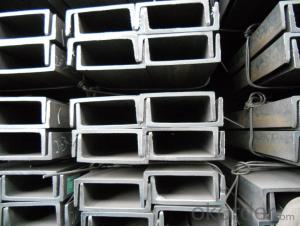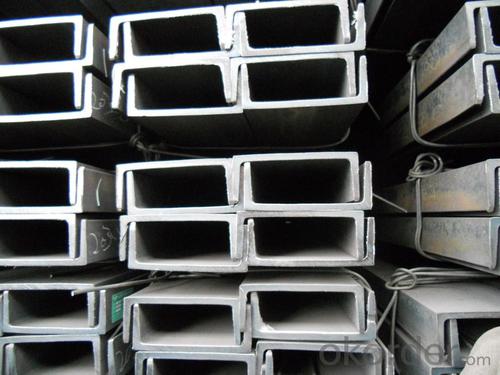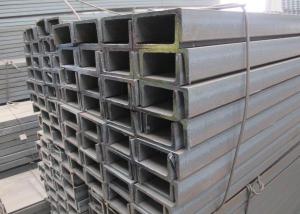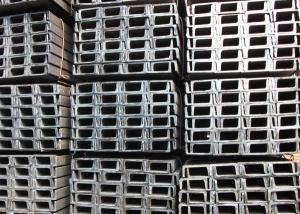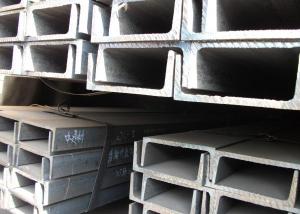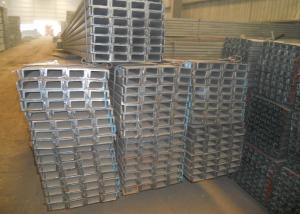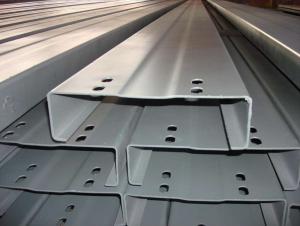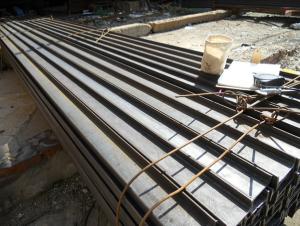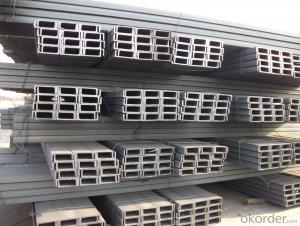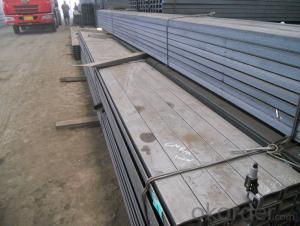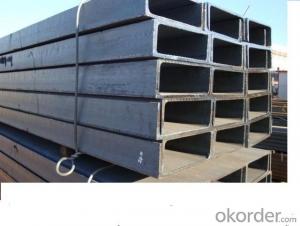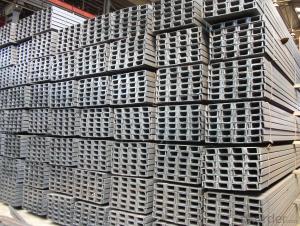High Quality 25# Steel Channel
- Loading Port:
- China Main Port
- Payment Terms:
- TT OR LC
- Min Order Qty:
- -
- Supply Capability:
- -
OKorder Service Pledge
OKorder Financial Service
You Might Also Like
Steel Channel
Standard: GB
Material: Q235
Length: 6m, 12m
Size:
| Size (mm) | Mass (Kg/m) |
| 250*78*7.0 | 27.410 |
| 250*80*9.0 | 31.335 |
| 250*82*11.0 | 35.260 |
The chemical composition of HR Channel Steel according to Q235B is shown in Table-1.
Alloy No | Grade | Element(%) | ||||
C | Mn | S | P | Si | ||
Q235 | B | 0.12-0.20 | 0.3-0.7 | ≦0.045 | ≦0.045 | ≦0.3 |
Table-1
Note: we are able to present our customers relevant SGS test report for chemical composition of HR Channel Steel.
The mechanical property of HR Channel Steel according to Q235B is shown in Table-2
Alloy No | Grade | Yielding Strength Point(Mpa) | |||
Thickness(mm) | |||||
≦16 | >16-40 | >40-60 | >60-100 | ||
≧ | |||||
Q235 | B | 235 | 225 | 215 | 205 |
Table-2
Package & Delivery of Channel:
1.The hot rolled channel steel will be packed in bundle with steel wire at each end of every bundle and color marking in order to help the customer to recognize his goods more easily at sight.
2. And the hot rolled channel steel could be loaded into 20ft or 40ft container, or by bulk cargo.If the weight of each bundle reaches more than 3.5 mt, the loading by break bulk cargo should be choosed.When the weight of each bundle reaches less than 3mt, the loading by container should be choosed.
3.As for the transportaion from mill to loading port, the truck will be usually used. And the maximum quantity for each truck is 40mt.
4.All in all, we could do in accordance with customer's request.
*If you would like to get our price, please inform us the size, standard/material and quantity. Thank you very much for your attention.
- Q: How do steel channels compare to other structural materials?
- Steel channels have many advantages compared to other structural materials. Firstly, steel channels are incredibly strong and have a high load-bearing capacity. They can withstand heavy loads and provide excellent structural support, making them suitable for a wide range of applications such as bridges, buildings, and infrastructure projects. Additionally, steel channels are highly durable and have a long lifespan. They are resistant to corrosion, rust, and degradation, which ensures that they can withstand harsh environmental conditions and maintain their integrity over time. This durability makes steel channels a cost-effective choice as they require minimal maintenance and replacement. Steel channels also offer design versatility. They can be easily fabricated and customized to meet specific project requirements. They can be cut, drilled, and shaped into various sizes and lengths, allowing for flexibility in design and construction. This adaptability makes steel channels suitable for both simple and complex structural applications. Moreover, steel channels have excellent fire resistance properties. They can withstand high temperatures for a longer duration compared to other materials like wood or aluminum. This makes them a safer choice for buildings and structures, as they provide additional time for evacuation and minimize the risk of collapse during a fire. Lastly, steel channels are environmentally friendly. They are made from recycled materials and can be recycled at the end of their lifespan, reducing the demand for raw materials and minimizing waste. This sustainability aspect makes steel channels a preferred choice for eco-conscious construction projects. Overall, steel channels are superior to other structural materials due to their strength, durability, design versatility, fire resistance, and environmental sustainability. Their numerous advantages make them a reliable and efficient choice for various construction applications.
- Q: Can steel channels be used in industrial applications?
- Yes, steel channels can definitely be used in industrial applications. Steel channels are versatile structural components that are commonly used in various industries due to their strength, durability, and load-bearing capabilities. They are often used to support heavy loads, provide structural stability, and create frameworks for machinery, equipment, and infrastructure in industrial settings. Steel channels are also utilized in construction, manufacturing, engineering, and transportation industries for applications such as building frames, conveyor systems, shelving units, bridges, and support beams. Moreover, steel channels can be easily fabricated, welded, and customized to meet specific industrial requirements, making them a popular choice in a wide range of industrial applications.
- Q: Do steel channels have any specific load distribution characteristics?
- Yes, steel channels do have specific load distribution characteristics. Steel channels are commonly used in structural applications as they provide excellent strength and load-carrying capacity. The load distribution characteristics of steel channels depend on their shape, size, and orientation. Steel channels typically have a C-shaped cross-section, with a flat back and two perpendicular flanges. The load distribution characteristics of steel channels are primarily influenced by the flanges. The flanges act as beams that resist bending and carry the applied load. The load is distributed along the length of the flanges, creating a load path that transfers the load to the supports or other structural elements. The load distribution characteristics of steel channels are also influenced by the size and orientation of the channel. Larger channels with wider flanges can distribute the load over a larger area, reducing the stress concentration. Additionally, the orientation of the channel, whether it is vertical or horizontal, can affect the load distribution characteristics. It is important to consider the load distribution characteristics of steel channels during the design and analysis of structures. Engineers need to ensure that the channels are properly sized and oriented to adequately distribute the applied loads. By considering these characteristics, steel channels can effectively distribute the load and contribute to the overall structural integrity and stability of a construction project.
- Q: Channel 12, span 5 meters, how much weight can be carried?
- 8.5 meters tall, *11.8, inside the half second layer, 3 wall, 11.8 meters side horizontal pull a beam (bearing), I would like to ask how much channel (GB)
- Q: Can steel channels be used for framing?
- Yes, steel channels can be used for framing. Steel channels are versatile and widely used in construction for various purposes, including framing. They are strong, durable, and provide structural support for buildings and other structures. Steel channels can be easily welded or bolted together to create a framework for walls, roofs, and floors. They are commonly used in industrial, commercial, and residential construction projects as they offer stability and resistance to bending and warping. Additionally, steel channels are available in a variety of sizes and thicknesses, allowing for flexibility in design and construction.
- Q: What are the different types of bracing systems used with steel channels?
- Steel channels can be combined with various bracing systems to meet the specific needs and requirements of a project. The following are a few examples: 1. Cross bracing: The most commonly used bracing system for steel channels involves diagonal members or cables arranged in a crisscross pattern between two or more steel channels. This type of bracing ensures an even distribution of the load and enhances the stability of the structure. 2. K-bracing: Rectangular or square buildings often employ K-bracing, which involves diagonal members or cables forming a K-shape between steel channels. It offers strong resistance against lateral forces. 3. Chevron bracing: Similar to K-bracing, chevron bracing also utilizes diagonal members or cables. However, in this system, the diagonal members form a V-shape or chevron pattern. Chevron bracing is ideal for structures with limited space, as it requires less material and allows for more open floor plans. 4. X-bracing: This bracing system uses diagonal members or cables arranged in an X-shape between steel channels. It is popularly used in buildings with long spans or high wind loads due to its excellent resistance against lateral forces. 5. Portal bracing: Buildings with large openings, such as garages or warehouses, often incorporate portal bracing. This involves adding diagonal members or cables to create a portal frame between steel channels. The purpose of this type of bracing is to distribute the load evenly and prevent deformation of the structure. 6. Eccentric bracing: Eccentric bracing is a specialized system that allows for controlled yielding during seismic events. It involves placing diagonal members or cables off-center from the vertical axis of the steel channels. This arrangement dissipates energy and minimizes the impact of seismic forces. These are just a few examples of the bracing systems compatible with steel channels. The choice of bracing system depends on factors such as structural requirements, building codes, and project-specific needs.
- Q: 10kV and below the distribution cabinet in the room, the basic channel should be higher than the indoor ground level? Which specification is clearly defined?
- Power distribution cabinet (box), power distribution cabinet (box) and lighting distribution cabinet (box), measuring cabinet (box), is the last stage equipment of power distribution system. Power distribution cabinet is the general term of motor control center.
- Q: How are steel channels installed on-site?
- Steel channels are typically installed on-site by first preparing the foundation or support structure. The channels are then positioned and aligned according to the design specifications. They are secured in place using welding, bolting, or concrete embedding methods. The installation process may also involve leveling, aligning, and ensuring proper connections with other structural elements.
- Q: Are steel channels suitable for swimming pool installations?
- Swimming pool installations do not lend themselves well to steel channels. Usually utilized for structural support or as a framework for substantial constructions such as bridges or buildings, steel channels lack the necessary qualities for swimming pool installations. In contrast, concrete or fiberglass materials are commonly employed due to their resilience, waterproof characteristics, and capacity to endure continuous contact with water and chemicals. Specifically engineered for swimming pool installations, these materials guarantee a dependable and enduring solution.
Send your message to us
High Quality 25# Steel Channel
- Loading Port:
- China Main Port
- Payment Terms:
- TT OR LC
- Min Order Qty:
- -
- Supply Capability:
- -
OKorder Service Pledge
OKorder Financial Service
Similar products
Hot products
Hot Searches
Related keywords
